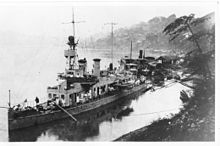SMS Otter (1909)
|
|
|
|---|---|
| Overview | |
| Type | River gunboat |
| Shipyard |
Joh. C. Tecklenborg , Geestemünde |
| Launch | July 15, 1909 |
| Commissioning | April 1, 1910 |
| Whereabouts | Confiscated March 13, 1917 Sunk October 19, 1929 |
| Technical specifications | |
| displacement |
Construction: 266 t |
| length |
KWL : 53 m |
| width |
8.65 m |
| Draft |
0.98 m |
| crew |
47 men and 7-11 Chinese helpers |
| drive |
|
| speed |
15.2 kn |
| Range |
4350 nm at 5 kn |
| Armament |
2 × 5.2 cm rapid loading cannon L / 55 |
| Bunker quantity |
87 tons of coal |
The SMS Otter was a river gunboat of the Imperial Navy , which was used from 1910 to 1914 as part of the German Yangtze patrol on the Yangtze in China and was subordinate to the East Asian cruiser squadron .
Construction and testing
The construction of the Otter was based on that of SMS Vaterland and SMS Vorwärts . The special feature was that machine parts of the Otter were provided with a special steel for better security against fire from light weapons. It also had more powerful machinery and two chimneys . The bottom of the ship was designed to be completely flat so that she could easily get up or down from the sandbanks of the Yangtze.
After the test drives on the Weser , the boat was dismantled into nine sections and transported to Shanghai at the end of 1909 on the steamer Marie Leonhardt of the Hamburg shipping company Leonhardt & Blumberg . The assembly was completed at the end of February 1910. The acceptance test took place on February 28, 1910 on the Wusung .
On March 19, 1910, the boat was inspected in Shanghai by the chief of the cruiser squadron, Vice Admiral Friedrich von Ingenohl , and put into service on April 1, 1910.
use
Until the end of 1910, the Otter operated on the Yangtze and Xiang Jiang . It only took 38 hours to overcome the rapids between Yichang and Chongqing , which was a record for a French warship. On December 15, 1910, she was taken out of service in Chongqing for wintering.
In 1911 the Otter operated again on the Yangtze after repairs in Shanghai. After the outbreak of the Chinese Revolution , she guided ships with fleeing foreigners to areas that were not affected by unrest. In the winter of 1911/12 she was decommissioned in Chongqing.
At the end of May 1912 it was thoroughly overhauled in Shanghai and then operated in that area. She stayed in Shanghai for the winter of 1912/13.
On March 31, 1914, she returned to her old area of operation. At the end of July 1914, the oldest naval officer of the East Asian station , Corvette Captain Karl von Müller , ordered her to be transferred to Hankou (now part of Wuhan ). After the outbreak of World War I it was launched in Nanjing . While a watch team stayed on board, the crew went to Tsingtau . As early as August 18, 1914, it was sold to a company in Nanjing to prevent foreign powers from accessing the boat. On the occasion of the sale, it was renamed Munich .
Whereabouts
After China entered the war on the side of the Allies, the Munich was confiscated by the Chinese authorities on March 20, 1917 and placed in the service of the Chinese Navy under the name Li-Tsieh .
In 1920 she was assigned to the Amur flotilla . The boat sank on October 16, 1929 after a Soviet air raid on the Sungari and was scrapped in 1932.
Commanders
- April / May 1910: Lieutenant Captain Oskar Kautter (1882–1920).
- May 1910 to May 1912: Lieutenant Captain Johannes Jantzen (1880–1945).
- May 1912 to March 1914: Lieutenant Captain Rudolph Firle (1881–1969).
- March to August 1914: Lieutenant Captain Heinz Seuffert (1884–?).
literature
- Cord Eberspächer: The German Yangtze Patrol. German Gunboat Policy in China in the Age of Imperialism 1900-1914 , Bochum 2004.
- Cord Eberspächer: German gunboat policy in East Asia , in: Hartmut Klüver (ed.): Foreign deployments of German warships in peace (Small series on shipping and naval history, Volume 7), Bochum 2003, pp. 13-30.
- Keyword: river gunboat Otter , in: Hans H. Hildebrand / Albert Röhr / Hans-Otto Steinmetz: The German warships. Biographies - a mirror of naval history from 1815 to the present , Ratingen o. J. (One-volume reprint of the seven-volume original edition, Herford 1979ff.,) Vol. V., p. 38.
- Günter Kroschel / August-Ludwig Evers (eds.): The German fleet 1848-1945. History of German warship construction in 437 pictures . 2nd edition, Wilhelmshaven 1963, p. XXVI.


